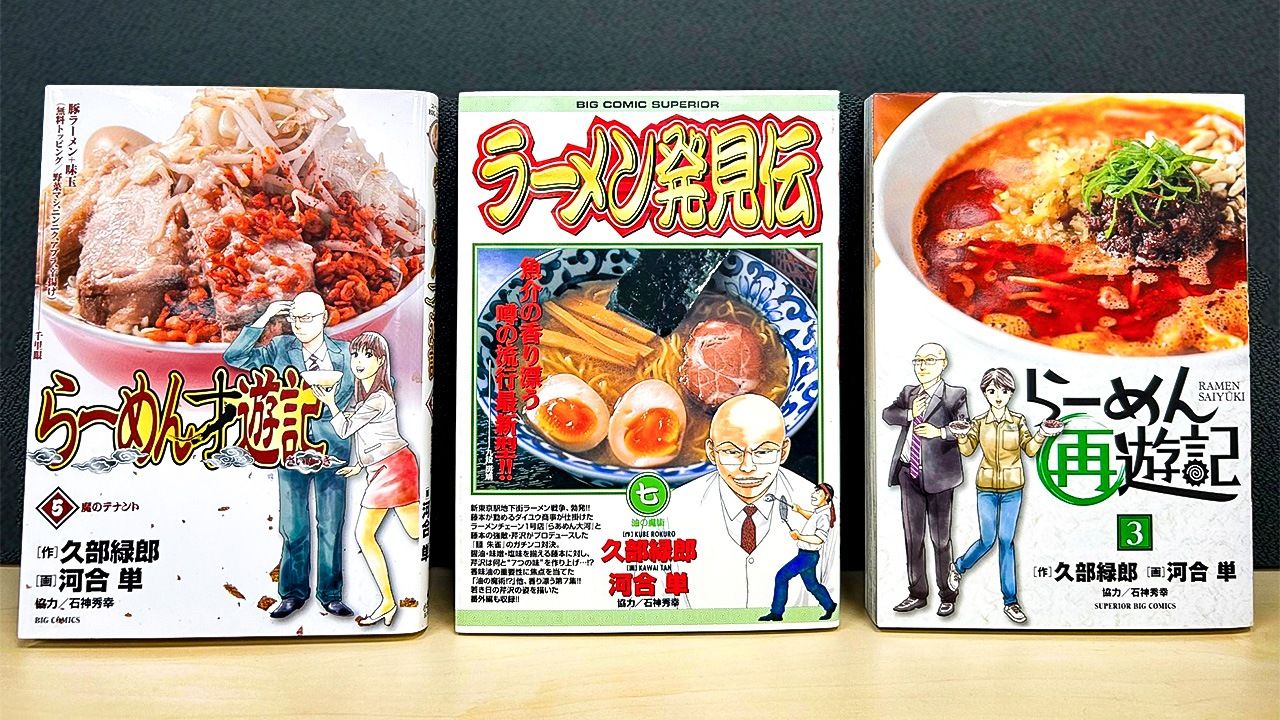
Manga as a Window on Japanese Culture
Manga Offer a Window on Japan’s Noodle Evolution
Food and Drink Manga- English
- 日本語
- 简体字
- 繁體字
- Français
- Español
- العربية
- Русский
The Growth of Japanese Ramen Culture
Japan is an island nation split from the continental mainland by sea. From the perspective of that mainland, Japan is the eastern end of the earth, and beyond it is the wide Pacific Ocean. In other words, it is something of a cultural cul-de-sac, and in the past the Japanese archipelago represented the eastern end of the Silk Road.
Since it has no land borders with other nations, its history lacks the kind of lively mutual motivation that Europe enjoyed, for example. That might explain why Japan has lacked for originality in idea or discovery, but there is also a clear trend in play: When something is introduced from another culture, the Japanese obsess over it and improve it to a level that can shock the originators.
That trend of unceasing cultural honing can be seen in ramen. Originally brought over from China, it became a staple of the Japanese working class in the early twentieth century. From there, it spread to reach true national dish status, and now is a worldwide phenomenon.
The breadth of variety is truly impressive. It still has a significant presence as a cheap, common meal people can casually enjoy alone while browsing magazines. At the same time, it has also made progress on the road toward high-class recognition with rare and costly ingredients. In 2014 the Michelin Guide to Tokyo initiated a new ramen category, and 2016 saw the very first Michelin-starred ramen restaurant appear.
That popularity has crossed international borders, and now there are YouTubers sharing their love of ramen with the world, like the American Brian MacDuckston. There are even hard-core plans like the “Eat six bowls of ramen in three hours” walking tour for tourists in Tokyo—which, by the way, appears to be booming. And of course, every region in Japan seems to have its own ramen culture.
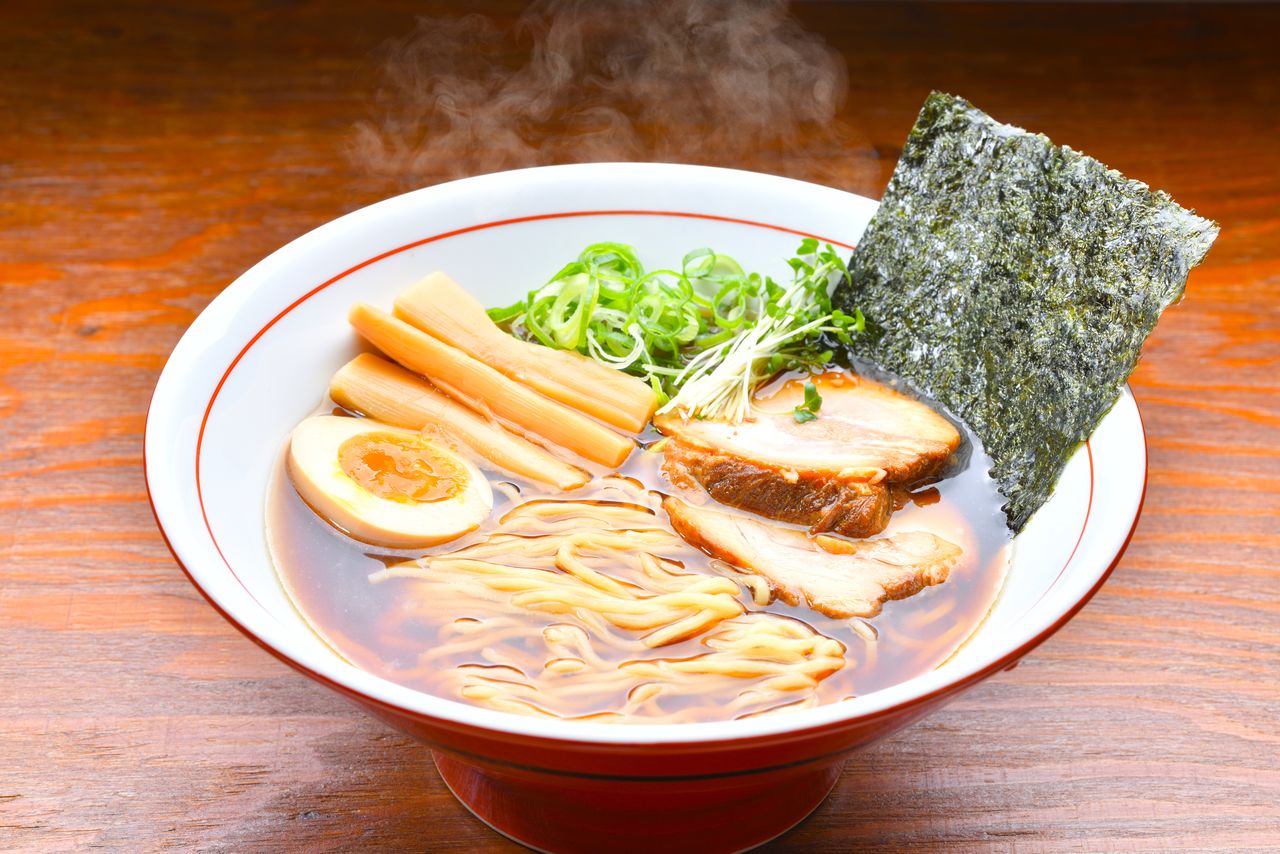
The long-time baseline for ramen in Japan has been the so-called Chūka soba, or “Chinese noodles,” using a soy sauce flavor base, but now there are so many varieties they’re almost beyond classification. (© Pixta.)
Enter Ramen Manga
With such a huge fanbase, naturally Japan has manga dealing with the world of ramen. Such works have a long history, with Mochizuki Mikiya’s Totsugeki rāmen (Ramen Charge!) becoming the first ramen manga serialized in Shōnen Jump magazine in the 1970s. The dish was already popular among the children reading this publication back then.
In the 1980s, the popular foodie manga Oishinbō (story by Kariya Tetsu, art by Hanasaki Akira) and Cooking Papa (Ueyama Tochi) both had ramen storylines. Oishinbō’s “Ramen War” arc of the early 1990s went particularly deep, with characters like the head of a “Ramen Culture Research Institute” and the “Three Ramen Musketeers.” By that time, ramen culture had already started to reach manic levels of fandom.
At the end of the twentieth century, a manga appeared that approached ramen as a genre all its own. That work is Ramen hakkenden, roughly meaning “tales of ramen discovery.” It entered serialization in Shōgakukan’s Big Comic Superior magazine in 1999. The story was by Kube Rokurō and art by Kawai Tan, and also credits ramen critic Ishigami Hideyuki, known as “the man with the divine palate,” as a collaborator. The work became widely known with catch copy like, “There’s a ramen manga out there to read!” and “This is a delicious ramen manga!” and it made an instant impression on manga history.
The protagonist of Ramen hakkenden is Fujimoto Kōhei, a 20-something employee of a trading company called Daiyū Shōji. His work, though, barely seems to matter, and he always makes sure to clock out at the stroke of five. No one thinks much of Fujimoto as an employee, but the man himself has a dream: He wants to run a ramen shop.
To make it come true, he starts training on his own, and in the evening puts out a stall serving ramen to passersby. His day job serves only to earn the capital to open a proper noodle shop.
Japan had already moved beyond the old thinking of, “If you give your all to your company, it will look after you your whole life.” It was a time when people were starting to use company employment as a tool for their own life plan. It was a way of living with potential.
As his own ramen mania burgeons, Fujimoto pushes himself to learn to make the dish. Though he is not yet at the true professional level, he has plentiful knowledge and a gifted palate. Along the way, his department moves into the dining industry, and he becomes involved in ramen in his day job, as well.
Now, he is dealing with ramen both on the clock and off. That setting allows Ramen hakkenden to share not only ramen’s historical development in Japan, but also the progress of the birth of new local trends and innovations in flavor and texture; the hidden side of the ramen industry, like the use of mass-produced and -distributed broth; and a comparison with other noodle varieties, like soba, which have already achieved more complete maturity. It is a rich source of information that brings even deeper enjoyment of ramen.
Visiting a ramen shop after a read is likely to result in a totally fresh experience of the dish, whether you’re in a chain shop or a venerable local hole-in-the-wall.
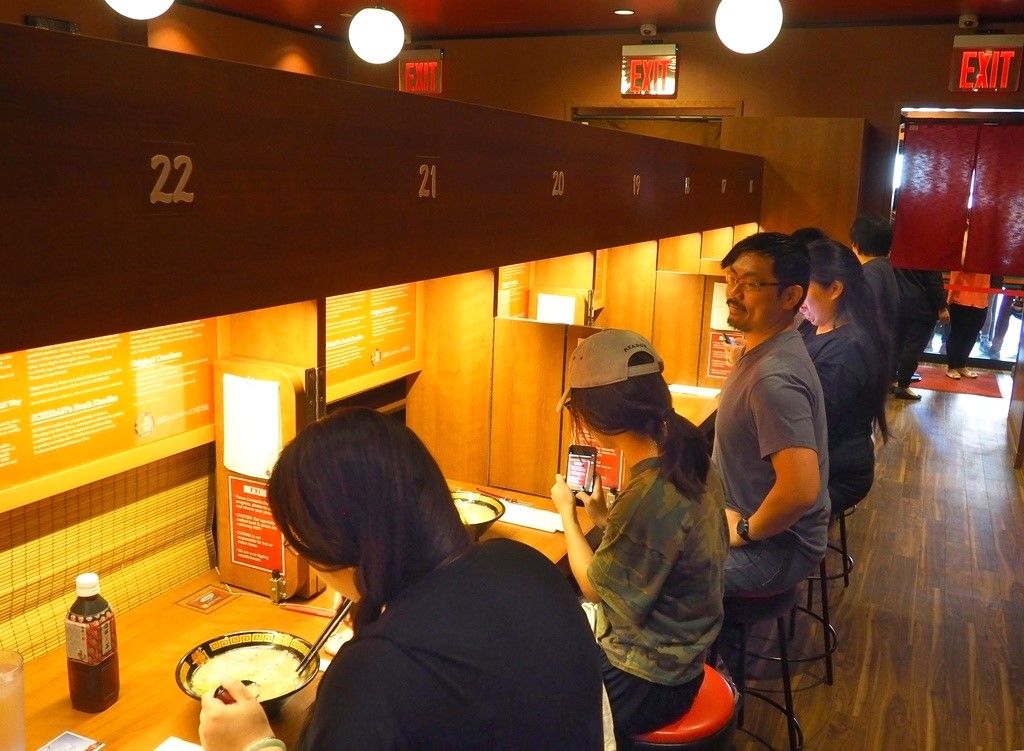
Ichiran, a chain popular with tourists visiting Japan from overseas, has started expanding abroad, with shops in New York and elsewhere. The style of eating at a counter with dividers between the seats caused a buzz when first introduced in Japan. (© Kyōdō)
A Key Figure in Understanding the Ramen Boom
In the manga, Fujimoto is faced with a huge barrier, the “final boss” character of Serizawa Tatsuya. Serizawa is the owner of the restaurant Ramen Seiryūbō and also works as a food coordinator. His media strategy is solid, making him something of a founding figure in the ramen boom.
Even as a serious businessman, though, he is also a ramen professional with the spirit of an artisan, to the point that he shaves his head to make sure no single hair ever falls into his soup.
The shaping of this character, Serizawa, brings a deeper, more diverse flavor to Ramen hakkenden.
Is it right to always, no matter the situation, make ramen with passion and fastidious attention? Are hardcore fans always unconditionally welcome? For an amateur, the answers to those questions might well be an unconditional “yes.” But for a true professional making ramen, a businesslike point of view is also necessary.
Rather than a subtly detailed flavor that only a few customers might be able to appreciate, offering an easy to grasp ramen made for maximum impact may be the right choice as a business.
Serizawa says of fanatics who talk more about their vast knowledge than the taste of ramen, “They’re not eating ramen, they’re eating facts!” But if using that hard core demographic has value in this age of the internet, he will use it. That is his stance.
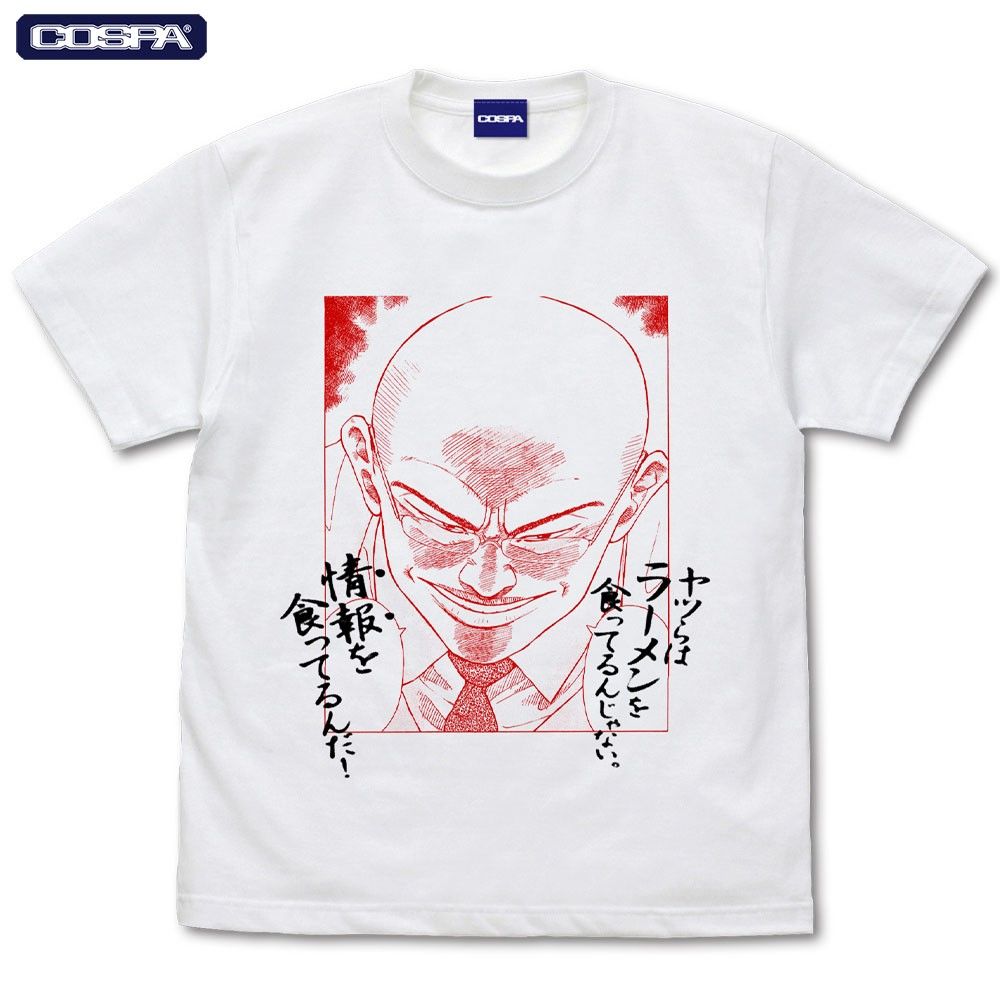
Serizawa has become such a popular character in the work that he’s now on t-shirts and other merchandise. (© Cospa; © Kube Rokurō, Kawai Tan, and Shōgakukan)
The hardened professional on one side, the brilliantly skilled amateur on the other. Serizawa often opposes Fujimoto, and it even comes down to a ramen duel. In the end, the media gets involved, and it becomes a direct showdown on a massive stage.
Serizawa was an important figure for Fujimoto. Even with his outstanding knowledge and passion for ramen, the latter is still just an amateur. His living comes from office work, and he cannot argue with the fact that ramen is still just a hobby for him. Eventually, he comes to realize that Serizawa had always been his guide.
Ramen hakkenden is set starting in the mid-1990s, a time when ramen was evolving in Japan as a unique, creative cuisine. From there, it continued in two follow-up series called Ramen saiyūki. The content shifts as it follows the development of ramen’s history beyond national borders and continues to convey the joys of the dish.
In the end, though, what, really, is ramen?
Serizawa has this to say: “It all boils down to the passion for taking the fake and making something real out of it.”
The history and tradition of ramen, as a creative cuisine, are still shallow compared to French or Chinese cuisine. Indeed, it was born as a food of the masses. In Oishinbō, the gourmand character Kaibara Yūzan dismissed ramen as a “vulgar food.” And from his viewpoint, it might well be so. Serizawa’s use of the word “fake” might be rooted in the same reason.
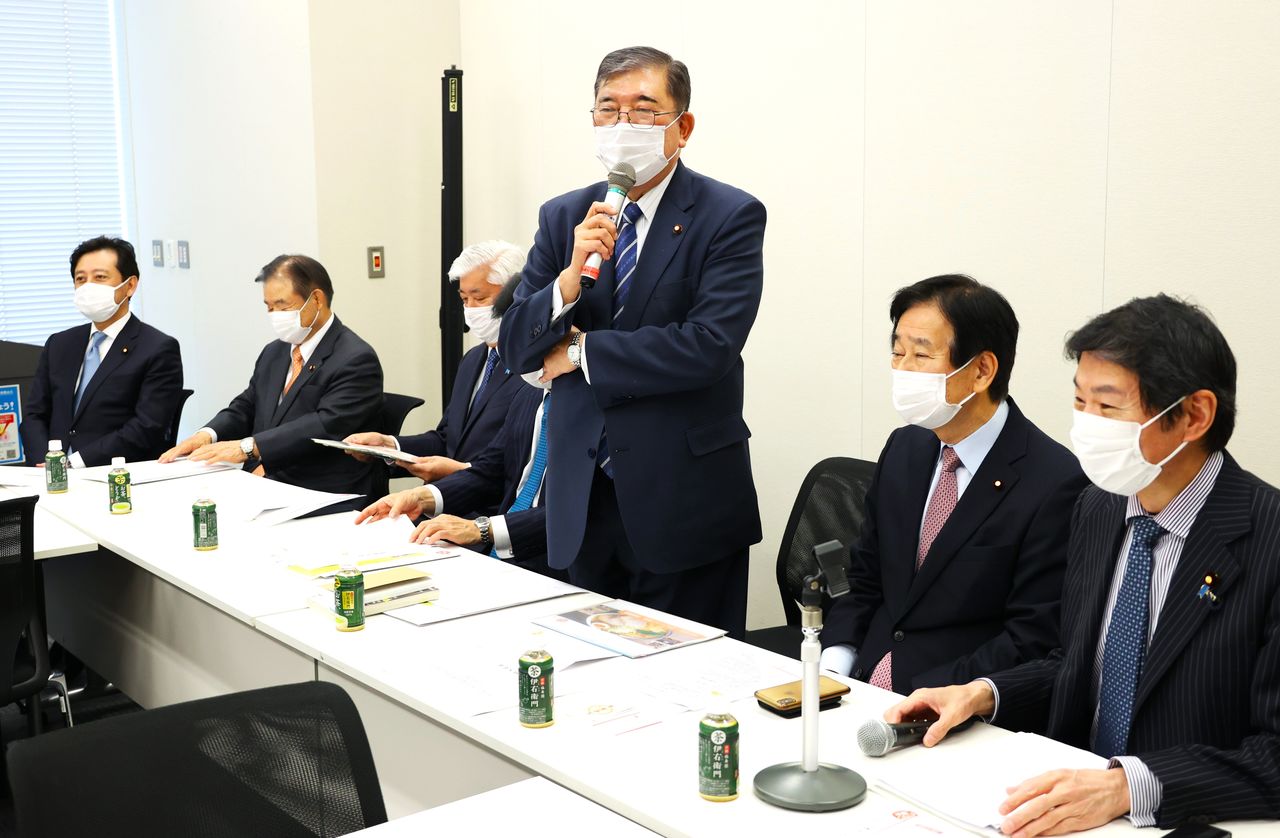
In April 2023, members of the National Diet established the Ramen Culture Promotion Diet Caucus, seeking to encourage regional revitalization through local ramen. (© Jiji)
Similarities Between Ramen and Manga
But ramen still holds all the potential of a new, unripe field. It changes day by day with the dynamic energy to display endless new developments.
That might well remind you of something else from Japan. Indeed, it is just like manga. Manga’s history and traditions are still shallow, and the artform was born as a simple entertainment of the masses, without any pretensions at high-brow expression. Those like Kaibara Yūzan, who value upper-class culture, might well devalue manga (though he himself is a character in just such a work!).
But the passion people pour into manga has nurtured it into a medium with global fans. And manga shares with ramen the spirit of taking in and honing international influences—European characters like Sherlock Holmes or Arsene Lupin, say, or expressive styles cribbed from American comic books.
Clearly, the creators of Ramen hakkenden worked on their manga from the conviction that “We are the same. Manga is the same.”
Now, in just the same way as ramen itself, manga about ramen is growing in diversity. There are works depicting ramen-loving high school girls, manga guides to ramen shops, dramatic stories about ramen artisans, or people whose lives have been changed by ramen. There are all kinds of ramen manga now.
Ramen is on its way to becoming an essential spice for the manga industry and an ever more important presence.
(Originally published in Japanese. Banner photo: Ramen hakkenden was serialized in Shōgakukan’s Big Comic Superior magazine from 1999 to 2009. The comics were collected into 26 volumes. After it finished, the story was continued in two different series under the Ramen saiyūki title. © Nippon.com.)